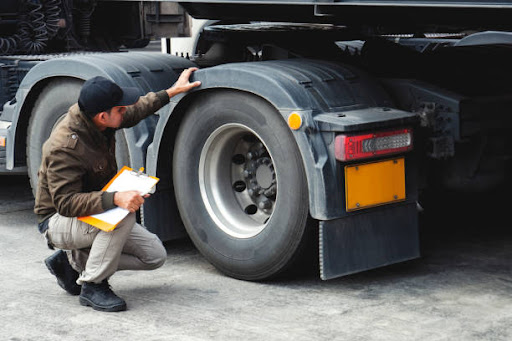Safety Tips for Truck Drivers

As truck drivers we play a critical role in the transportation industry, moving goods all across the country and keeping the economy running smoothly. However, driving a big truck comes with its own set of unique challenges and safety risks. The importance of safety for truck drivers cannot be overstated – not only for us drivers but also for other motorists on the road.
In this article, we will discuss essential safety tips that all truck drivers should follow to ensure our own safety and the safety of others on the road. These tips cover a range of topics from pre-trip inspections to defensive driving techniques to proper load securement.
The Importance of Safety for Truck Drivers
Driving a commercial vehicle, particularly long-haul trucking, can be physically demanding and mentally exhausting work. Fatigue, distractions, and stress on the body can all contribute to an increased risk of accidents on the road. Additionally, trucks are much larger and heavier than most other vehicles on the road, which means that accidents involving commercial vehicles often have more severe consequences.
Ensuring that truck drivers are aware of these risks and equipped with proper training and safety protocols is essential for reducing accidents and fatalities on the road. Furthermore, promoting safe driving habits helps maintain public trust in the transportation systems while preserving business interests by minimizing cargo damage or delays caused by accidents or equipment problems.
Overview of 21 Safety Tips
In this article, we will discuss 21 important safety tips that every truck driver should incorporate into their daily routines:
- Conducting a thorough pre-trip inspection
- Properly securing cargo to prevent shifting or falling off during transport
- Distribute weight evenly
- Being aware of surroundings and anticipating potential hazards
- Maintaining a safe following distance
- Adjusting driving habits based on weather conditions
- Slowing down and increasing following distance in adverse weather
- The importance of being prepared for adverse weather
- The importance of rest breaks
- Taking regular breaks to avoid fatigue
- How to take effective rest breaks
- Always wearing seat belts and ensuring all safety equipment is in working order
- Maintaining your safety equipment
- Keeping dispatchers informed about any delays or issues on the road
- Avoiding distractions such as cell phones or eating while driving
- Effective strategies for avoiding distractions
- Adhering to posted speed limits and reducing speed in work zones
- Ensuring proper lane usage while driving
- Stay in the right lane unless passing
- Avoid aggressive driving
- Be mindful of blind spots
By implementing these safety tips, truck drivers can help prevent accidents and ensure that they arrive at their destinations safely.
Read also: Fueling Health: Road-Ready Tips for Truckers’ Healthy Eating
Pre-Trip Inspection
Conducting a Thorough Pre-Trip Inspection
As a truck driver, it is essential to conduct a pre-trip inspection to ensure that the vehicle is in good condition before hitting the road. A thorough pre-trip inspection can help avoid accidents from occurring due to vehicle malfunctions.
The first step of the pre-trip inspection is to inspect the exterior of the truck. Check for any signs of damage, including dents, cracks, or any other visible issues.
Ensure that all lights are working as they should and that reflectors are intact and not peeling. Next, check all tires for proper inflation and signs of wear and tear such as bulges, cuts, or uneven wear.
It’s important to make sure all lug nuts on wheels are tightened and secure before starting on your trip. Don’t forget to inspect brakes, including brake pads, shoes, and rotors, and ensure there are no leaks and enough brake fluid in the system.

Checking Tires, Brakes, Lights, and Other Important Components
Tires play a crucial role in ensuring safety while driving a truck. Checking tire pressure regularly can avoid costly damage while also increasing fuel efficiency. Inspect each tire for punctures or cuts by closely examining them from top-to-bottom and side to side.
In addition to tires, brakes play an essential role in ensuring safety while driving on highways which frequently have sudden stops or slowdowns due to traffic congestion or construction zones. It’s important to always keep them maintained according to the manufacturer’s recommendations.
Check other components such as mirrors which should be clean and adjusted correctly as well as windows that need free movement up and down if power-operated. Conducting regular inspections – both daily walkarounds before you hit the road every day – provides peace of mind knowing your vehicle has been thoroughly checked over before starting long trips with heavy loads safely — avoiding complications down the road that could have otherwise been prevented.
Load Securement
Preventing Shifting or Falling Cargo
One of the most critical aspects of trucking safety is load securment. Failure to properly secure freight can lead to serious accidents, injuries, and even fatalities.
A shifting or falling load can cause a driver to lose control of their truck, collide with other drivers on the road, or cause damage to property. Therefore, it is very important that truck drivers take the necessary steps to ensure that our freight is secured and tightly in place during the trip.
Truck drivers must carefully examine their loads before transporting them and use proper techniques and materials for securing them. Straps, chains, ropes, or cables are commonly used methods for tying down cargo.
The type of securing method used depends on the size and type of freight being transported. Moreover, it’s important to consider other factors that could affect the load’s securment during the trip: for instance, how tight should straps be tightened?
What kind of knots are best suited for various types of loads? Taking these factors into account will help prevent unexpected situations from causing accidents.
Distributing Weight Evenly

Another important consideration when loading a truck is ensuring even weight distribution throughout the vehicle. Uneven weight distribution can make a vehicle unstable and hard to handle while driving on the road due to issues such as uneven wear on tires and suspension systems – this could lead to an accident. Even if you have secured your cargo properly during transit- an unbalanced weight distribution will increase wear and tear in certain parts and components over time which will eventually result in maintenance costs for repairs or replacements if left unchecked.
This undesirable scenario can be avoided by taking time during the pre-trip to ensure that all heavy items are balanced correctly across all axles/ compartments. Ultimately, preventing shifting or falling off cargo- coupled with evenly distributed loads- helps promote stability while driving a truck – thus decreasing potential hazards along the way.
Defensive Driving
Being Aware of Your Surroundings and Anticipating Potential Hazards
Truck drivers must always be aware of their surroundings and anticipate potential hazards. This means keeping an eye on the road ahead, checking mirrors frequently, and scanning for any potential obstacles, such as other vehicles, pedestrians, or debris on the roadway.
In addition to keeping a lookout for hazards, truck drivers must also be aware of weather conditions, traffic patterns, and road construction. Defensive driving requires being prepared for any situation that may arise while on the road.
To maintain awareness of their surroundings and anticipate potential hazards, truck drivers should practice defensive driving techniques such as maintaining a safe following distance, and reducing speed in work zones or bad weather conditions. These techniques can help prevent accidents before they happen.
Maintaining a Safe Following Distance
Maintaining a safe following distance is crucial to defensive driving. The recommended following distance for trucks is at least four to six seconds behind the vehicle in front depending on your speed and under normal circumstances.
However, in inclement weather or at higher speeds it may be necessary to increase this distance. By maintaining a safe following distance between vehicles on the road, truck drivers have more time to react to sudden stops or changes in traffic patterns.
This can help prevent rear-end collisions which are among the most common types of accidents involving trucks. In addition to giving sufficient space between vehicles while driving being aware of blind spots or unpredictable driver behavior like sudden lane changes without signaling are other possible hazardous situations that could occur while driving can be avoided by maintaining safe distances from all vehicles.
Defensive driving is an essential component of safety for truck drivers on the road. By being aware of surroundings and anticipating potential hazards while also maintaining a safe following distance between other vehicles these practices will not only ensure safer travels but also reduce accidents that cause injury or death. By following these defensive driving techniques, truck drivers can help protect themselves and others on the road.
Weather Conditions
Adjusting Driving Habits Based on Weather Conditions
One of the biggest challenges for truck drivers is navigating different weather conditions while on the road. Driving in rain, snow, or ice requires a different approach to driving and increased attention to safety.
Adjusting driving habits based on weather conditions is crucial to prevent accidents and ensure that cargo arrives safely at its destination. When driving in adverse weather conditions, it’s important to slow down and increase the following distance between vehicles.
This gives drivers more time to react if there is an unexpected situation on the road. Additionally, it’s essential that drivers have good visibility, which may require using windshield wipers or defrosting windows before starting their journey.
Slowing Down and Increasing Following Distance in Adverse Weather
Another important aspect of adjusting driving habits in adverse weather is slowing down. When roads are wet or icy, stopping distances can increase dramatically compared to dry roads.
By slowing down and increasing the distance between vehicles, drivers can avoid collisions with other vehicles or objects on the road. It’s also important for truck drivers to be aware of how their vehicles will handle different weather conditions.
For instance, if a driver encounters black ice on the road, they should avoid braking quickly as this could cause the vehicle to skid out of control. Instead, they should slowly reduce speed until they regain control of their vehicle.
The Importance of Being Prepared for Adverse Weather
Preparation is key when it comes to driving in adverse weather conditions. Drivers should always check weather reports before heading out on a journey and be prepared with chains or other equipment that might be needed in snowy or icy conditions. Additionally, drivers should make sure that their vehicle has adequate tread depth on tires as well as proper tire pressure levels for optimal handling in adverse weather.
Adjusting driving habits based on weather conditions is essential for the safety of truck drivers and other road users. By slowing down, increasing the following distance, and being well prepared for changing weather conditions, truck drivers can ensure that they arrive at their destination safely and without incident.
Rest Breaks
Truck drivers spend long hours on the road, which can be both physically and mentally exhausting. Taking regular rest breaks is essential to avoid fatigue and maintain alertness while driving. Studies have shown that driving while fatigued can be just as dangerous as drunk driving, so it’s crucial for truck drivers to prioritize their rest breaks.
The Importance of Rest Breaks
Rest breaks allow truck drivers to take a break from the monotony of the road and refresh themselves both physically and mentally. Taking a short nap or stretching your legs during your break can help reduce fatigue, improve circulation, and alleviate muscle stiffness. Additionally, taking regular rest breaks can help prevent burnout and reduce stress levels.
According to federal regulations, truck drivers are required to take a minimum of 30 minutes off duty after eight hours of continuous driving time. However, many experts suggest taking shorter breaks more frequently throughout the day can be even more beneficial for ensuring driver safety.
How to Take Effective Rest Breaks
The key to taking effective rest breaks is planning ahead. Before starting your trip, plan where you’ll stop for rest breaks along the way.
Select safe locations with ample parking space where you can take a break without disrupting traffic or putting yourself at risk. During your rest break, it’s important to make the most of your time off duty.
Taking proper care of yourself during this time includes getting some fresh air or going for a short walk around the parking lot area in order to stretch out muscles that have been sitting for long periods of time. Additionally eating healthy snacks such as fruits & nuts instead of high-sugar foods will prevent crashes later in the day from insulin spikes followed by crashing energy levels.
Taking regular rest breaks is essential for truck driver safety on long-haul trips. Drivers who prioritize their health by getting enough sleep and taking breaks can help reduce the risk of accidents caused by fatigue and keep themselves alert and focused while on the road.
Seat Belts and Safety Equipment
The Importance of Wearing Seat Belts
Wearing a seat belt is one of the simplest and most effective ways to protect yourself in the event of an accident. As a truck driver, it is essential to always wear your seat belt when operating your vehicle. Not only is it required by law, but it can also save your life in the event of a crash.
According to studies by the National Highway Traffic Safety Administration (NHTSA), wearing a seat belt reduces the risk of fatal injury for drivers and passengers by 45-60%. In addition to wearing your seat belt, it’s important to ensure that all passengers in your vehicle are also properly restrained.
This means making sure they are wearing their seat belts or using child safety seats if necessary. By taking this extra step, you can help prevent injuries and save lives in the event of an accident.
Maintaining Your Safety Equipment
Another important aspect of truck driver safety is ensuring that all safety equipment on your vehicle is in good working order. This includes things like airbags, ABS brakes, and other safety features that may be included on newer trucks. Regular maintenance and inspections can help ensure that these systems are functioning properly and will provide the protection you need in case of an accident.
Additionally, you should always carry emergency supplies like flares or reflective triangles so that you can alert other drivers if you do need to pull over for any reason. It’s also a good idea to keep a first aid kit on board so that you have access to basic medical supplies if needed.
By taking these steps, you can help ensure that you are prepared for any situation that may arise while out on the road as a truck driver. Not only will this help keep you safe, but it will also give you peace of mind knowing that you are doing everything you can to protect yourself and those around you.
Communication with Dispatchers

Keeping dispatchers informed about any delays or issues on the road
Effective communication with dispatchers is critical to ensure the smooth and safe operation of a trucking company. As a truck driver, you must keep your dispatcher informed about any delays or issues that may arise while you are on the road.
This helps them plan their schedules accordingly and can prevent problems down the line. One of the best ways to stay in touch with your dispatcher is through the use of technology such as cell phones or GPS tracking systems.
These tools allow you to share your location, speed, and other relevant information in real time. This can help your dispatcher route you around traffic jams or other obstacles that may delay your delivery time.
Another important aspect of communication with dispatchers is maintaining a professional demeanor at all times. Remember that your dispatcher is there to help you and support your efforts on the road.
Be courteous and respectful when speaking with them, even if you are experiencing frustration due to unexpected delays or other issues. It’s important to follow up with your dispatcher after each delivery to let them know how things went.
If there were any problems or challenges along the way, be sure to share this information so that they can make adjustments for future trips. By staying in close contact with your dispatcher and communicating effectively throughout each trip, you can help ensure a successful and safe journey on the road.
Avoiding Distractions
The Dangers of Distracted Driving
Distracted driving is a leading cause of accidents on the road, and truck drivers are no exception. Any activity that diverts a driver’s attention from the road is considered a distraction. This includes using cell phones, eating or drinking, grooming, adjusting the radio or GPS, or even daydreaming.
When driving a large vehicle such as a truck, distractions can have even more serious consequences. For example, taking your eyes off the road for just five seconds to read a text message at highway speeds means you will travel the length of a football field without looking at the road.
In that time, anything could happen – and it often does. In fact, according to the National Highway Traffic Safety Administration (NHTSA), distracted driving claimed 2,841 lives in 2018 alone.
Effective Strategies for Avoiding Distractions
The good news is that most distractions are entirely preventable with some simple strategies:
1. Put your phone away: Keep your phone out of reach while driving and resist the urge to check it until you are safely pulled over.
2. Use hands-free devices: If you must use your phone while driving for work purposes or to navigate unfamiliar roads, use hands-free devices such as Bluetooth headsets.
3. Avoid eating while driving: Eating while behind the wheel is not only distracting but also dangerous if food spills or obstructs your view.
4. Set up before departure: Adjust temperature settings and mirrors before starting your trip so that you don’t have to take your eyes off the road once you’re underway.
5. Take breaks frequently: Taking regular breaks can help refresh your focus and reduce fatigue while driving.
Distracted driving poses significant risks to everyone on the road, but truck drivers are especially vulnerable due to the size and weight of their vehicles. By following these simple strategies, you can stay focused on the road and keep yourself and other motorists safe during your trips. Remember, it only takes a few seconds of distraction to cause a lifetime of regret.
Speed Limits
As a truck driver, it is important to always adhere to posted speed limits. Speeding can not only result in fines, but it can also increase the risk of accidents due to decreased reaction time and reduced control over the vehicle. It is essential to obey speed limits, especially in residential areas and on roads with heavy traffic. In addition, reducing speed in work zones is crucial as construction crews are often working near the roadways and unexpected obstacles may be present. When driving a large commercial vehicle like a truck, it is even more important to drive at a reasonable pace that suits the vehicle’s size and weight.
A fully loaded semi-truck requires more time and distance to stop than a passenger car or smaller vehicle. Therefore, if an emergency arises on the road ahead, such as stopped traffic or debris blocking the road, slowing down earlier than usual can help avoid collisions. Moreover, maintaining proper speeds helps conserve fuel consumption and extends tire life on long hauls. Unnecessary acceleration can lead to increased fuel consumption while going too slow can wear down tires quickly due to excessive friction with the road surface.
Adhering To Work Zone Speed Limits: Protecting Workers
Driving through work zones require extra care from all drivers on the road. Traffic patterns may have changed suddenly; there could be narrow lanes or barriers close by; workers may be present just beyond temporary obstructions; sharp curves or bumps may cause sudden changes in handling dynamics for vehicles traveling at high speeds especially for trucks carrying heavy cargo.
The American Transportation Research Institute (ATRI) cites that nearly 30 percent of fatal work zone crashes involved large trucks between 2015 and 2017 alone. The organization advises drivers to follow posted speed limits within work zones and maintain ample space between themselves and other vehicles on roadsides, especially if there are workers present.
It is also important to keep an eye out for flaggers who are often placed at critical points within work zones to manage traffic flow. It’s important to understand that fines for speeding or reckless driving in work zones are typically doubled and law enforcement agents strictly enforce these laws.
Most importantly, though, it is crucial to slow down in these areas simply because human lives are at risk. The safety of everyone involved in a construction project is of the utmost importance, and it’s essential that truck drivers do their part by adhering to posted speed limits.
Proper Lane Usage
Stay in the Right Lane Unless Passing
One of the most important safety tips for truck drivers is to stay in the right lane unless they need to pass. This allows other vehicles to pass safely on the left and helps maintain a consistent flow of traffic. When passing, it’s important to signal before changing lanes and make sure there is enough space to move over safely.
Avoid Aggressive Driving
Aggressive driving can be dangerous for any driver, but it’s especially hazardous for truck drivers due to their large size and weight. Avoid tailgating, cutting off other drivers, or engaging in road rage. These actions not only increase the risk of an accident but can also result in fines or license suspension.
Be Mindful of Blind Spots
Trucks have large blind spots that can make it difficult for drivers to see cars around them. It’s important for truck drivers to be aware of these blind spots and adjust their driving accordingly by checking mirrors frequently, using turn signals, and avoiding sudden lane changes.
Final Thoughts
Truck driving can be a challenging job that requires a lot of skill and focus on safety. By following these 17 safety tips, truck drivers can help reduce their risk of accidents on the road.
While there are always risks associated with driving long distances, taking steps like conducting thorough pre-trip inspections, securing loads properly and staying alert while on the road can make all the difference in preventing accidents. Remember: when you arrive safely at your destination every time you hit the road – you did your job right!
Frequently Asked Questions
How can truckers prevent accidents caused by driver fatigue?
- Truckers can prevent accidents caused by driver fatigue by adhering to hours of service regulations, taking regular breaks, maintaining a consistent sleep schedule, and recognizing the signs of fatigue to rest when necessary.
What are some common road hazards that truckers should be aware of?
- Common road hazards include aggressive drivers, adverse weather conditions, construction zones, potholes, and debris on the road. Truckers should be vigilant and adapt their driving accordingly to mitigate these risks.
What safety technologies can truckers utilize to enhance trucker safety?
- Truckers can utilize safety technologies such as collision warning systems, lane departure alerts, electronic stability control, and advanced braking systems to enhance trucker safety on the road.
How can truckers maintain their physical and mental well-being?
- Truckers can maintain their physical and mental well-being by practicing regular exercise, eating healthy meals, getting sufficient sleep, and seeking support for mental health concerns. Prioritizing self-care is essential for overall well-being.
What should truckers do in case of an emergency on the road?
- In case of an emergency, truckers should contact the appropriate authorities, provide assistance to those involved if safe to do so, and follow company protocols for reporting incidents. Being prepared with emergency kits and communication devices is also crucial.
How can truckers promote a safety culture within their organization?
- Truckers can promote a safety culture within their organization by leading by example, actively participating in safety training and programs, reporting safety concerns, and providing feedback for continuous improvement.
What are some upcoming trends in trucker safety?
- Emerging trends in trucker safety include advancements in automation, connectivity, and data analytics. These technologies aim to enhance safety measures, improve efficiency, and reduce risks associated with trucking operations.










